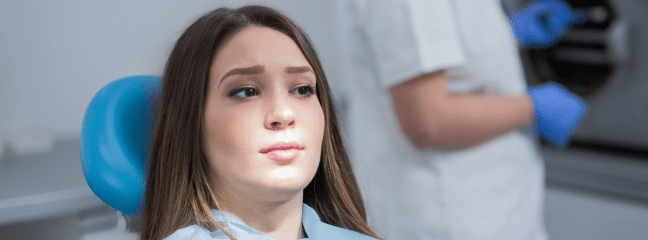If you’re paying for benefits but something’s keeping you from going to the dentist, don’t worry. You’re not alone! Dental care utilization among working-adults is at its lowest level since dental care use tracking began in 1996.
Fear is a major contributor to this. Dental anxiety is number 5 in the list of most commonly feared situations.
We’re bringing information and education to those who struggle with dental anxiety or a fear of going to the dentist. This can help those with a fear of the dentist discover tools to make an appointment a calm and stress-free visit.
WHAT YOU’RE LOSING WHEN YOU WAIT ON YOUR FEAR OF GOING TO THE DENTIST
Going to the dentist allows preventive care like cleanings and checkups to be done by a dentist you trust. And (great news!) these are typically covered at the highest percentage of the plan’s allowance. This gives you a financial incentive to get regular checkups and cleanings, which helps prevent the need for more extensive procedures and will save money in the long run!
COVERAGE ON BASIC PROCEDURES
Often, adults with dental anxiety wait until their tooth hurts to think about the dentist. Not only is this a bummer for the patient, but the work needed isn’t covered like preventive care.
Basic procedures are like the next level up. They work to repair damage with things like fillings and gum treatment. Basic procedures are usually reimbursed at a slightly lower percentage than preventive care.
COVERAGE ON MAJOR PROCEDURES
Don’t wait to see your dentist until you need major work done. Major procedures, such as crowns and root canals, are usually reimbursed at the lowest percentage (for example, 50%), increasing your out-of-pocket costs. By practicing good habits for selecting a dentist, anyone with a fear of going to the dentist can become comfortable with regular visits.
WHAT WE RECOMMEND:
GET TO KNOW YOUR DENTIST
Interview your dentist (or want to find a new one?). You should be comfortable getting to know your dentist and they should be comfortable getting to know you. It may seem silly, but if you can’t look your dentist in the eye, why would you let them in your mouth?!
Let them know what exactly intimidates or worries you about visiting the dentist. Be as specific as you can, because the dentist can do a variety of things to make your experience positive.
Experiment with white noise, meditations, music, and headphone while in the dentist chair. Music and white noise can sooth and distract. Opting to use a speaker over headphones allows you to communicate with the dentist during the appointment, as well.
SMELLS TO SOOTHE
Aromatherapy is a great way to transport yourself out of the dentist chair, while still getting your bi-annual cleanings. Using lavender essential oils can provide an “anxiolytic effect,” or an anxiety-reducing effect.
“[The] Anxiolytic effect of lavender was superior to placebo in 221 patients suffering from anxiety disorder. In addition, lavender improved associated symptoms such as restlessness, disturbed sleep, and somatic complaints and had a beneficial influence on general well-being and quality of life.”
To state it simply, the smell of lavender was effective in improving anxiety, restlessness, and boosted well-being when compared to those who had no aromatherapy.
Dab some on your wrists or bring the essential oil bottle to your appointment. Hold the bottle under your nose when you start feeling butterflies in your stomach.
PHYSICAL COMFORTS
It’s important that you do everything you can to be physically comfortable during your dental appointment. Loose fitting, soft clothing is best.
Weighted blankets are commonly used for children and pets to reduce anxiety, and they’re effective for adults too! Aimed at being a “wellness” product, 63% of adults in this study reported lower anxiety after use. Bring a weighted blanket or ask your dentist if they have any on hand when you schedule your next cleaning.
LIMIT UNFAMILIAR SIGHTS
All of your senses are equally important for a relaxing dentist appointment experience, sight included. If the sight of a needle or other equipment makes your heart race, tell the dentist! Many patients call beforehand to remind their dentist that they don’t like seeing needles or unfamiliar equipment.
Something as simple as laying a cloth over the dental tools to avoid seeing them can reduce the fear of going to the dentist.
When you have dental benefits but don’t go to the dentist, you’re giving away your money and collecting NONE of the benefits! There’s a reason they’re called benefits, they benefit you!
If you have any concerns about visiting the dentist, be sure to speak with your dentist to help alleviate your fears.
If you need help understanding your current benefits plan or are interested in signing up, contact us.


